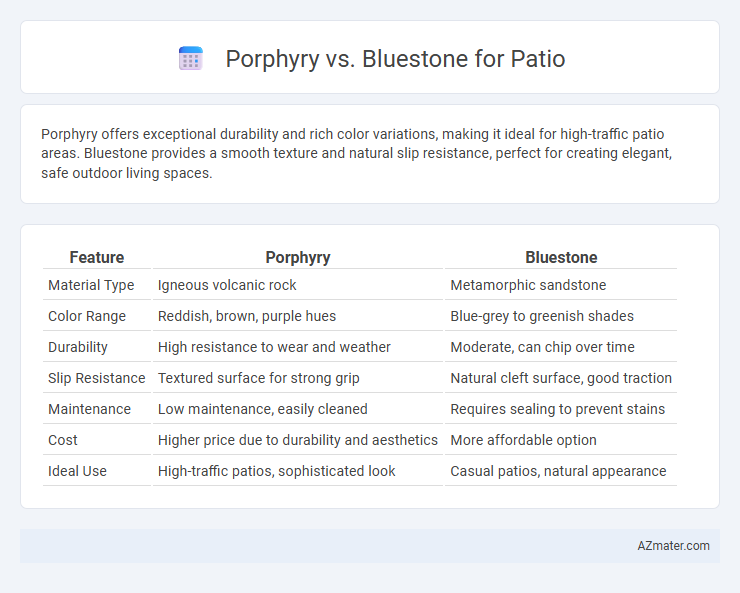Porphyry offers exceptional durability and rich color variations, making it ideal for high-traffic patio areas. Bluestone provides a smooth texture and natural slip resistance, perfect for creating elegant, safe outdoor living spaces.
Table of Comparison
| Feature | Porphyry | Bluestone |
|---|---|---|
| Material Type | Igneous volcanic rock | Metamorphic sandstone |
| Color Range | Reddish, brown, purple hues | Blue-grey to greenish shades |
| Durability | High resistance to wear and weather | Moderate, can chip over time |
| Slip Resistance | Textured surface for strong grip | Natural cleft surface, good traction |
| Maintenance | Low maintenance, easily cleaned | Requires sealing to prevent stains |
| Cost | Higher price due to durability and aesthetics | More affordable option |
| Ideal Use | High-traffic patios, sophisticated look | Casual patios, natural appearance |
Introduction to Porphyry and Bluestone
Porphyry is a durable igneous igneous volcanic rock characterized by its coarse-grained texture and rich reddish or purplish hues, making it an excellent choice for patios requiring long-lasting strength and unique aesthetics. Bluestone, a dense sandstone known for its smooth texture and natural blue-gray color variations, provides a versatile and elegant surface ideal for both traditional and contemporary patio designs. Both stones offer excellent durability and slip resistance, but their distinct mineral compositions and color palettes cater to different stylistic and functional preferences in outdoor living spaces.
Geological Origins and Composition
Porphyry, derived from volcanic activity, features large feldspar crystals embedded in a fine-grained matrix, offering durability and rich color variations. Bluestone, primarily a sandstone composed of quartz and feldspar, originates from sedimentary deposits, known for its consistent blue-gray hue and layered texture. Both stones provide natural strength for patios, but Porphyry's volcanic composition lends increased hardness compared to Bluestone's sedimentary formation.
Color and Visual Appeal
Porphyry offers a rich, deep red to purple hue with unique flecks of black and white that create a visually striking and luxurious patio surface. Bluestone presents a serene palette of blue-gray tones with subtle variations, lending a calm and elegant appearance ideal for modern outdoor spaces. Both stones provide distinct color characteristics, with Porphyry standing out for bold vibrancy and Bluestone excelling in understated sophistication.
Durability and Longevity
Porphyry exhibits exceptional durability due to its volcanic origin, making it highly resistant to wear, weathering, and heavy foot traffic, ideal for long-lasting patios. Bluestone, a dense sedimentary rock, also offers strong durability but tends to be more susceptible to chipping and erosion over time compared to Porphyry. For longevity in outdoor settings, Porphyry generally outperforms Bluestone, maintaining its structural integrity and appearance with minimal maintenance over decades.
Surface Texture and Slip Resistance
Porphyry offers a naturally rough and uneven surface texture that enhances slip resistance, making it ideal for patios exposed to moisture or heavy foot traffic. Bluestone provides a smoother, honed finish, which is visually appealing but may require additional treatments or coatings to improve traction on wet surfaces. Choosing porphyry ensures durable, non-slip performance, while bluestone requires maintenance for optimal safety.
Climate Suitability and Weather Resistance
Porphyry offers exceptional durability and withstands extreme weather conditions, making it ideal for regions with heavy rainfall, freezing temperatures, and intense heat due to its dense, volcanic composition. Bluestone, known for its natural slip resistance and moderate porosity, performs well in temperate climates but may require sealing to resist moisture penetration and weather-induced wear in harsher environments. Both materials deliver strong weather resistance, but Porphyry's superior density and hardness provide enhanced long-term performance in challenging climates compared to Bluestone.
Installation Process and Complexity
Porphyry patios require skilled craftsmanship due to the stone's hardness and irregular shapes, demanding precise cutting and fitting for a stable surface, which increases installation time and labor costs. Bluestone offers a smoother, more uniform surface, simplifying installation with easier cutting and fitting, resulting in faster completion and lower labor expenses. Both materials necessitate proper base preparation and joint filling, but porphyry's installation complexity often suits experienced masons, while bluestone is more accessible for DIY projects.
Maintenance Requirements
Porphyry patios demand low maintenance due to their high durability, natural resistance to stains, and ability to withstand harsh weather without frequent sealing or repairs. Bluestone, while aesthetically pleasing, requires more regular upkeep including sealing to prevent staining, moss growth, and potential surface erosion from exposure to moisture. Choosing porphyry reduces long-term maintenance efforts and costs, making it ideal for busy homeowners seeking a durable patio surface.
Cost Comparison
Porphyry patios typically cost between $20 to $50 per square foot, reflecting the stone's durability and unique texture, while Bluestone ranges from $15 to $40 per square foot, offering a more affordable yet still high-quality option. Installation expenses for Porphyry may be higher due to the stone's hardness and required cutting tools, whereas Bluestone's relative softness can reduce labor costs. Overall, Bluestone presents a cost-effective solution for patios without compromising on aesthetic appeal and long-term performance.
Sustainability and Environmental Impact
Porphyry offers high sustainability with its natural volcanic origins and exceptional durability, reducing the need for frequent replacements and minimizing resource consumption. Bluestone, sourced from sedimentary rock, supports eco-friendly construction through its longevity and recyclable properties, though quarrying practices can vary in environmental impact. Both materials provide low carbon footprints compared to manufactured alternatives, with Porphyry generally favored for its superior resilience and lower maintenance requirements in sustainable patio design.

Infographic: Porphyry vs Bluestone for Patio
 azmater.com
azmater.com